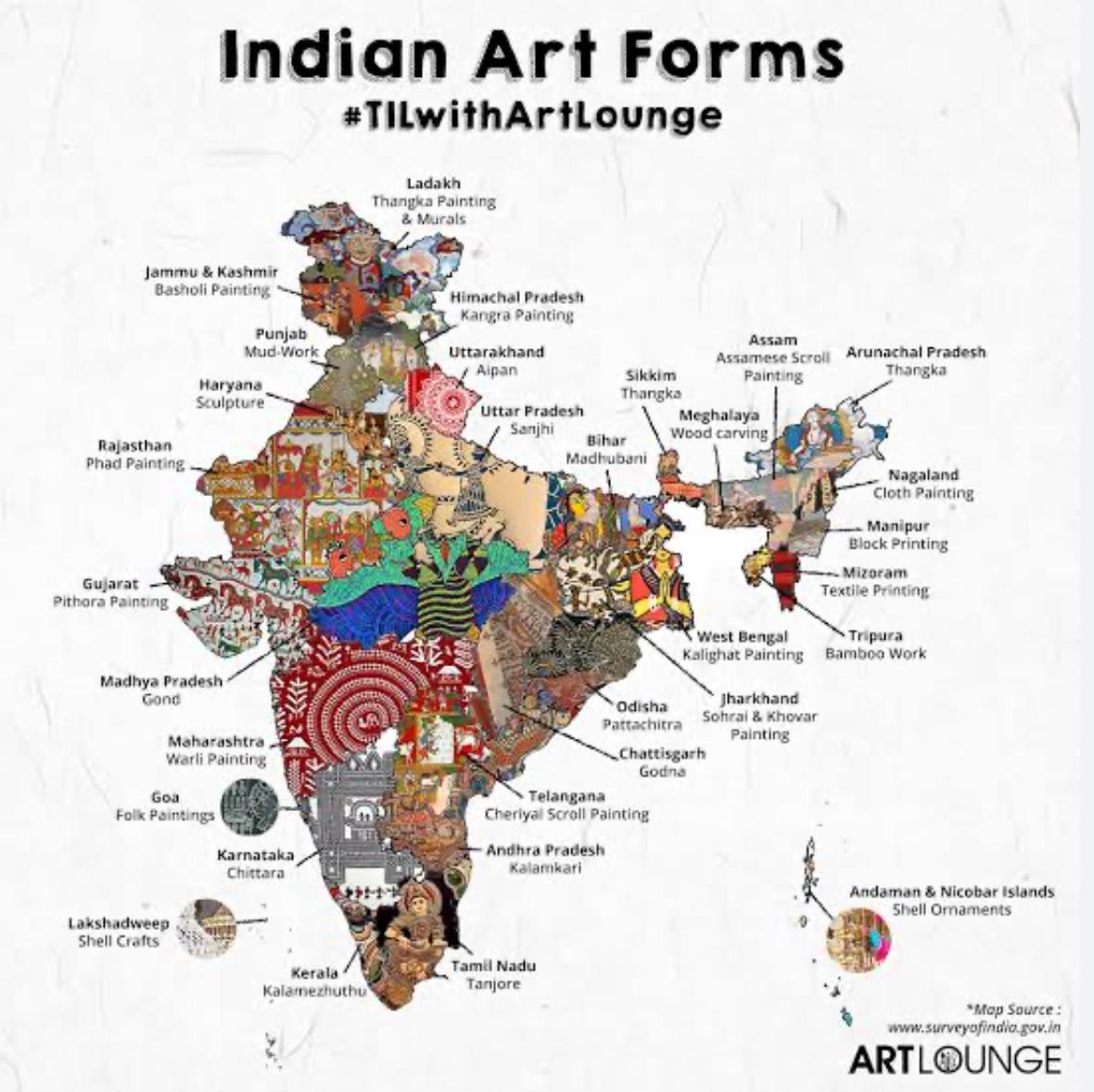Folk and Tribal Art
Folk and Traditional Art Forms of India across an assortment of media such as pottery, drawing, metalwork, paperwork, weaving, and designing items such as jewellery and toys. These are not just aesthetic objects, but they have a significant meaning in the specific culture, traditions, and regions of India.
Indian artform themes are as varied as Indian culture itself. An individual may still be familiar with the reemerging symbols of deities, fauna, and flora, courteous life and customs, among other images often created by folk artists. Let’s explore the most popular, aesthetically creative, and ancient traditional art forms of India:
Madhubani Paintings
Madhubani Art is one of the most popular traditional art forms found in India. It originated in the district of Madhubani in the Mithila district of Bihar. These paintings also include features such as abstract geometric forms. These geometrical patterns symbolize commitment, love, vitality, peace, and prosperity. They are well known for depicting ceremonial content on important occasions such as birth or marriage and festivities. Fun Fact: Madhubani art is not just a culturally relevant art form, it has been used to reduce deforestation as well! In 2012, various artists drew Madhubani paintings depicting gods and goddesses on trees to stop people from felling trees in Bihar.
Pattachitra
Pattachitra or Patachitra, another traditional art form of India, is a common term for contemporary, cloth-based scroll painting based in the East Indian states of Odisha and West Bengal. The name Pattachitra is adapted from the Sanskrit language, patta, implying canvas, and Chitra, meaning image. Therefore, Pattachitra is a painting rendered on canvas, illustrated by the affluent colorful display, imaginative motifs, and designs, and a representation of cardinal themes, often mythological in the portrayal.
Mysore Painting
Mysore Painting is a valuable form of classical South Indian portray, which emerged in and around the town of Mysore in Karnataka, facilitated and cherished by the kings of Mysore. Like many classical and traditional art forms of India, Mysore Paintings typically depict Hindu gods, goddesses, and Indian mythology tales. They are renowned for their beauty, textures, and attention to detail.
Tanjore Paintings.
This style of the traditional art form of Indian painting arose in the late phase of South Indian classical art when the civilization in which it emerged was going through tumultuous times. These Tanjore paintings are distinguished by vibrant, simple colors, homely compositions, resplendent gold foil work, and the use of glass beads and often precious and semi-precious gems.
Rajput Painting
Also known as the Rajasthan painting, this traditional art form of India came into existence and developed in the imperial court of Rajputana in northern India, notably in the 17th and 18th centuries. They are characterized by bold lines, intricate detailing, fine brush strokes, and vivid, eye-catching colours. These works are adorned all over the world
Fun Fact: Kalamkari is one of the ancient fabric painting art which is completely organic.
Warli Painting
Warli painting is a traditional art form of India created mostly by tribal people from the North Sahyadri Range in Maharashtra, India. Warli is an authentic expression of Maharashtra’s daily and social events and is used by the tribes to beautify their housewalls.
Fun Fact: Worli paintings can be dated back to 3000 BC, making it one of the oldest art forms in India and the world!
Gond Painting
Gond paintings are a type of folk and traditional art form of India, practiced by one of the largest tribes in India. The most entrancing aspect of Gond’s art is the use of vibrant colors. These colors are naturally derived from plant sap, leaves, colored soil, charcoal, and sometimes cow dung.
Fun Fact: The Chhipa community in Rajasthan has preserved the traditional hand-block printers and handloom dyers in India.
Kalamezhuthu
Kalamezhutha is a rare traditional art form of India found in Kerala. Natural substances are used for the Kalam ritual, also known as dholichithram or powder drawing. Colors are extracted from plants and it is a ceremonial art form of Kerala, where the form of the god is drawn on the floor using five forms of colored powders. It is a ritualistic art performed in the temples and holy groves of Kerala, where deities such as Kali and Lord Ayyappa are depicted on the ground.
Phad
Phad painting or phad is a form of religious scroll painting, and, a traditional art form of India practiced in Rajasthan. Traditionally, this is done on a long piece of fabric or canvas, known as a phad. Though each of them is culturally important, Rajasthan’s Phad painting stands out in particular for its complex identity, roots, and efforts to revive it.
Miniature Paintings
Miniature Paintings are a delicate form of traditional art in India. It flourished under the Mughal dynasty during the 16th-18th century AD but its history can be traced back to the 7th century in India. Miniature paintings are small, delicate pieces of art that use perishable items like cloth, paper, leaves, etc.
Miniature Paintings are a delicate form of traditional art in India. It flourished under the Mughal dynasty during the 16th-18th century AD but its history can be traced back to the 7th century in India. Miniature paintings are small, delicate pieces of art that use perishable items like cloth, paper, leaves, etc.
Indian Art Forms Today
Artistic forms of India have been appreciated over time, and their presence today reflects the efforts made to preserve them. Handmade crafts are a mirror of the cultural identity of the people who make them their own.
Channapatna, in the Ramanagara district of Karnataka, is one of the best places to explore the best modern arts and paintings in South India. This quaint town is renowned for its wooden toys, and is also known as the “Gombegala Nagara,” i.e. the town of toys.
India’s culturally rich heritage and centuries of the evolutionary traditional art form of India are evidenced by the great variety of handicrafts created throughout the country.

